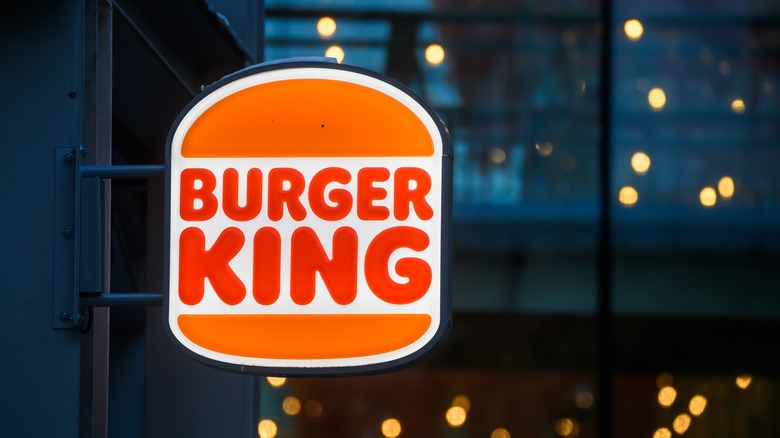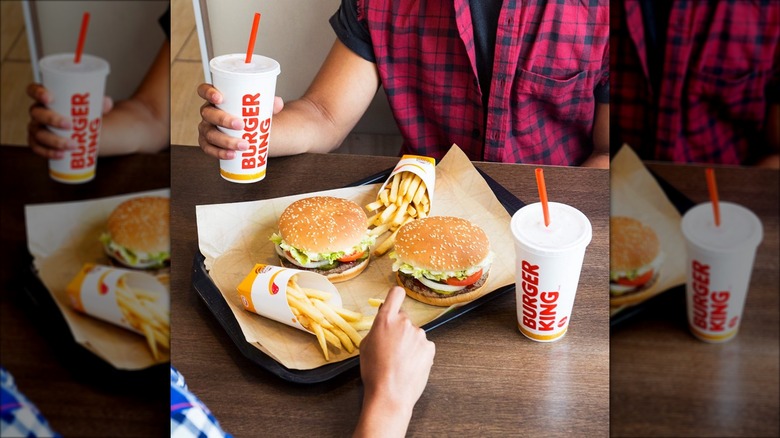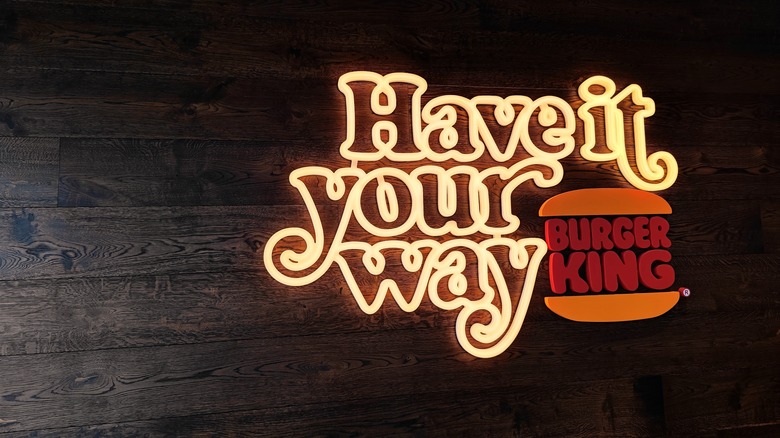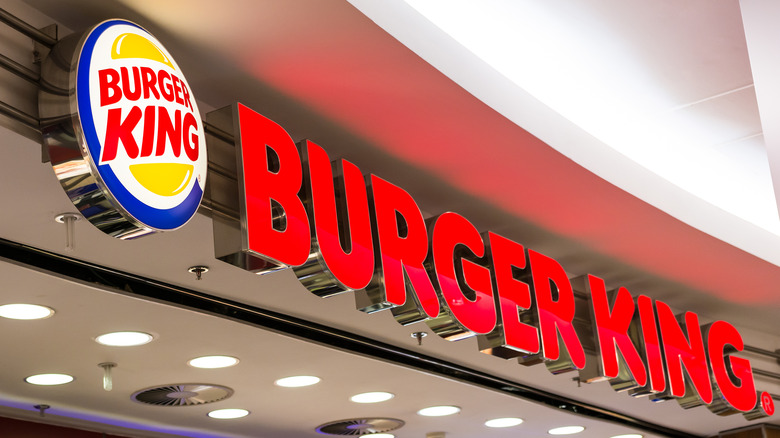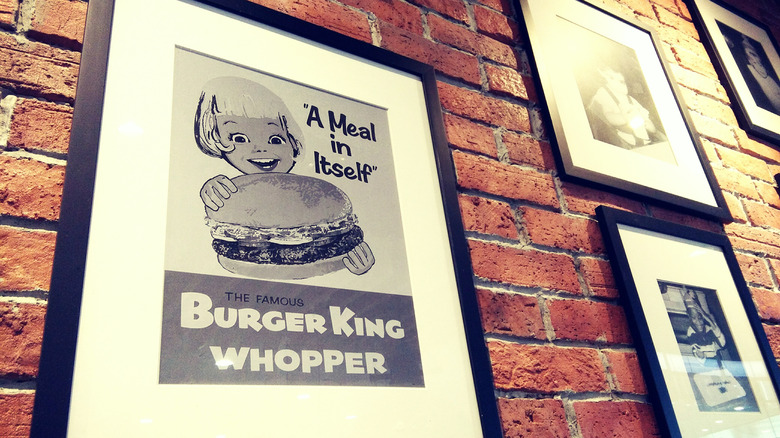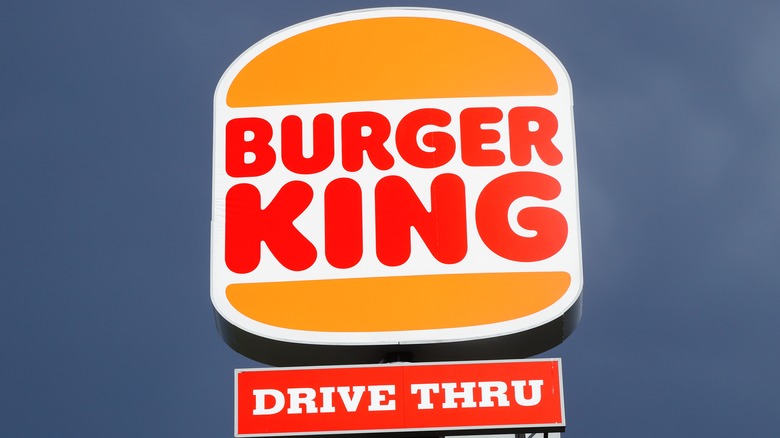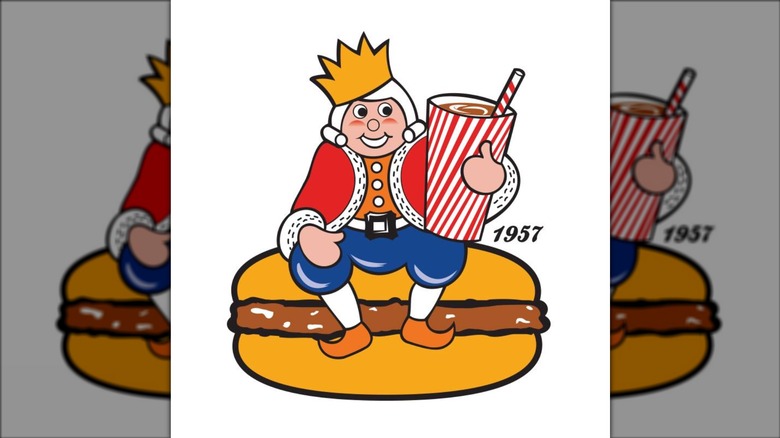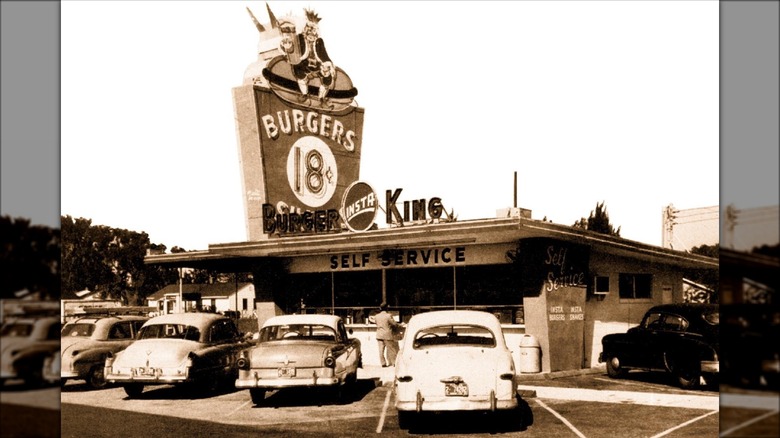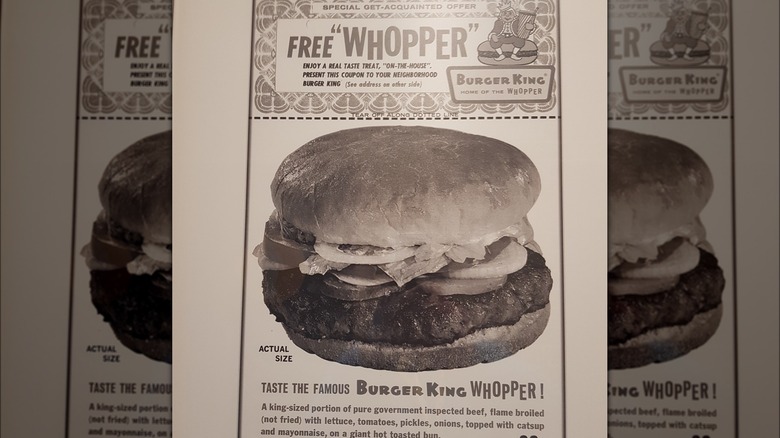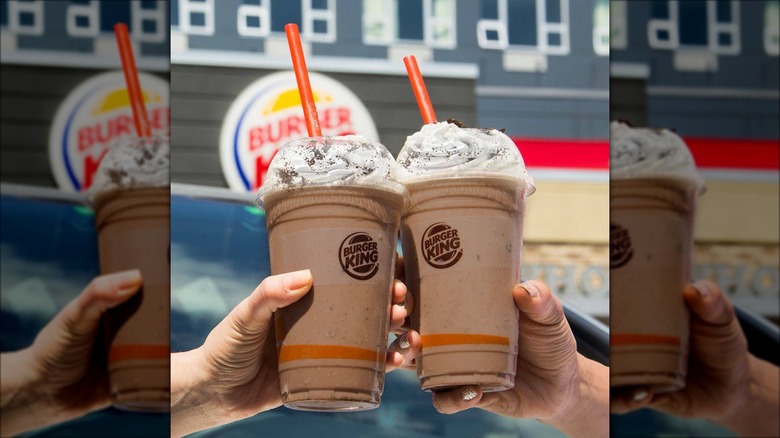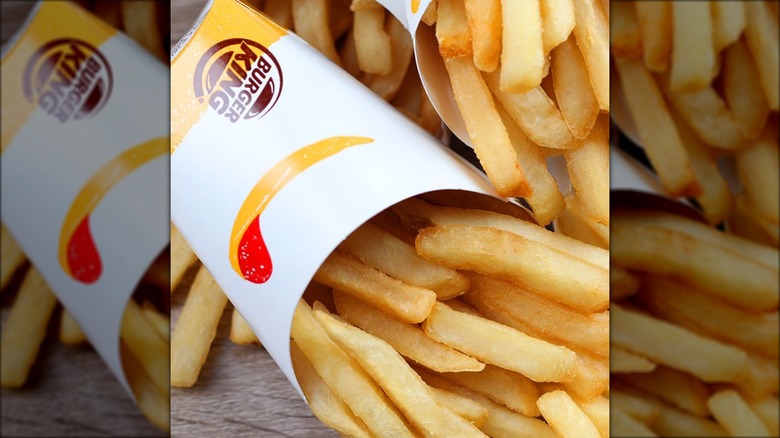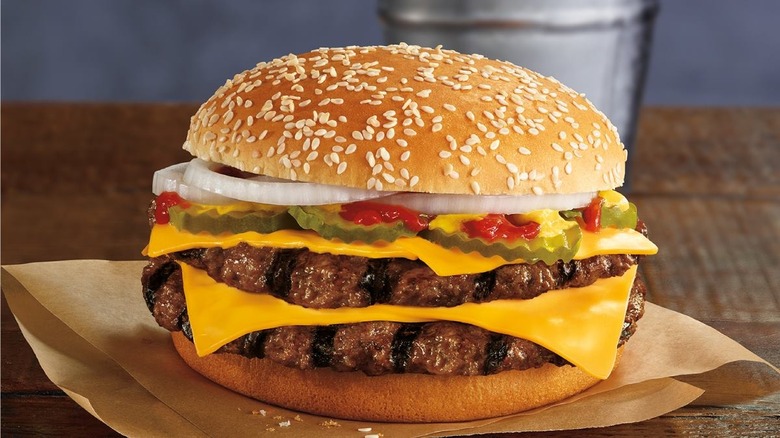What It Was Really Like To Eat At The First Burger King
In the United States, you are likely never too far away from a Burger King. In fact, according to its parent company Restaurant Brands International, there are currently over 18,700 franchises of this fast food behemoth located around the globe. The fast food chain is known for things like its signature Whopper sandwich, which has been on the menu for most of the company's nearly 70-year lifespan. But before there were any Whoppers, Burger King was still serving up interesting history, like hamburgers made from an innovative machine that sparked the growth of one of the largest fast food chains in the country.
Burger King had rather humble beginnings, however. If you were in the mood for a hamburger back in 1953, you would have visited a small, independently-owned restaurant that went by a different name. Within its first year, this small burger stand would become Burger King, officially founded in 1954 by partners James McLamore and Dave Edgerton, according to Britannica. With its patented machine known as the "Insta Broiler" (via The Burger King Book) and two business-savvy owners at the helm, Burger King quickly grew and added more locations around America, rivaling McDonald's.
Let's take a trip back in time before the advent of Whoppers, creepy king mascots, and a series of questionable menu items made their way onto BK menus. Here's a glimpse at what it might have been like to visit the first Burger King.
You might have thought you were at a McDonald's
The fan-fueled rivalry between McDonald's and Burger King is about as classic as the one between baseball teams like the Red Sox and the Yankees, or feuding clans like the Hatfields and the McCoys. The comparison between the two burger brands dates back to Burger King's earliest days when the restaurant's co-founders sought to replicate the success of its golden-arched older sibling. It all began when Keith Kramer and his wife's uncle, Matthew Burns, purposefully set out to create a hamburger chain after they visited a McDonald's location in California (via LiveAbout).
That initial spark to create a burger shop that was darn near identical to McDonald's is perhaps why the two chains are still so closely compared decades later. The two even entered into what was dubbed the "Burger Wars" in the 1970s, when Burger King publicly came after McDonald's over the size of its hamburgers, as per Forbes.
Ultimately, McDonald's remains the fast food top dog to this day, with over 38,000 locations worldwide (via McDonald's). Still, the fight's not over yet. Customers will certainly have their own opinions as to which business has the best hamburger, french fries, or milkshakes — but we all know that the menus are nearly identical. And though it's technically got a smaller footprint, Burger King has claimed that it offers higher quality ingredients, according to Business Insider. By all accounts, the rivalry is still going strong.
It used to have a different name
No, of course, Siri did not pop into being in 1953. But if that sort of technology did exist back then, it would likely have a hard time locating the first Burger King if you were to ask it for directions. That is because the first Burger King went by a slightly different name that would stymie most apps today.
When co-founders Keith Kramer and Matthew Burns decided to open up their McDonald's-inspired burger restaurant, they began searching for ways to differentiate themselves from what would become their biggest competitor. The answer, in part, was found in an innovative machine that could produce multiple hamburgers in an "instant," according to LiveAbout. Drawing on the speedy nature of this machine led to the name "Insta-Burger King" (via Business Insider).
However, the original iteration of Insta-Burger King didn't see as much success as Kramer and Burns may have hoped. Once the company was bought out just a few years later, the "Insta" was dropped and the chain became the "Burger King" we know so well today.
The first Burger King as we know it was in Florida
Though it may seem to be a simple affair, there is some confusion as to where the official first Burger King location opened. The Insta-Burger King opened by Kramer and Burns appeared in Jacksonville, Florida, as per Business Insider. Yet Burger Beast and Britannica both claim that Burger King's first location was in Miami. So, which one is it?
If we are going by the title alone, the first proper Burger King opened its doors in Miami. When James McLamore and Dave Edgerton founded the Burger King Corporation in 1954 along with a business partner, they were running the newly-opened Miami location. Meanwhile, the Jacksonville location, which opened a year prior in 1953 under the name "Insta-Burger King," was operated by Keith Kramer and Matthew Burns (via Miami New Times). The Burger King Corporation would expand from that point with additional locations built within the first year and eventually took over the parent company.
If you were to visit Burger King's website today, the chain will tell you that it was founded in 1954. That's not the whole story as technically, this launch would not have happened were it not for the Jacksonville, Florida location making its debut in 1953. Put more simply, the true origins of the restaurant chain might come down to who you ask.
The owners left Burger King soon after starting
The original co-founders of Insta-Burger King, Keith Kramer and Matthew Burns, would be the owners of their burger chain for only a short year. They quickly found out that they would need additional support if they wanted their burger shop to grow and compete with the likes of other burgeoning fast food giants such as McDonald's. During a financial rough patch as the company tried, business partners James McLamore and Dave Edgerton stepped in. They offered $20,000 for Insta-Burger King's Miami location, according to The Burger King Book. That 1954 purchase breathed new life into the financially struggling burger shop. This move was to be pivotal; McLamore and Edgerton founded the Burger King company as we know it today when the Miami location was acquired.
McLamore and Edgerton continued to run the company until 1967, when it was then sold to Pillsbury for $20 million, as per the Washington Post. Burger King has changed hands several times since then. As of 2021, the fast food chain is owned by Restaurant Brands (via Yahoo News).
A Burger King in Illinois claimed it was first
You might think the fight's over — but wait, a third contestant has just entered the ring to claim the throne as the first Burger King! If the Jacksonville and Miami debacle wasn't confusing enough, just wait until we throw the seemingly humble Burger King of Mattoon, Illinois into the mix.
Years before Keith Kramer and Matthew Burns opened their first Insta-Burger King, Gene and Betty Hoots were looking to add to their ice cream shop in Illinois, which they had deemed Frigid Queen. They thought the queen needed a king, so they decided to open up a burger shop and call it Burger King. They then moved forward to copyright the name in the state (via Wait Five Minutes).
But a burger empire was brewing in the south. The other Burger King's success in Florida meant that it was now looking to expand across the country. The Florida-based chain opened its first Illinois location in the town of Skokie in 1961. This drew the attention of the Mattoon Burger King to the point of them suing the corporate giant in what would be known as Burger King of Florida, Inc. v. Hoots. In a true David and Goliath turn of events, the Mattoon location won its battle. To this day, no corporate Burger King can open within a 20-mile radius of the family-owned business. According to Atlas Obscura, the closest Burger King to Mattoon is currently 23 miles away.
Its first logo did not feature burgers or kings
According to Business Wire, Burger King went through a bit of a visual rebranding in 2021. The new look was introduced in a sleek campaign video (via YouTube) and encompassed a redesign of the company's packaging and employee uniforms, as well as its all-important logo. That logo was last revised in 1999 but, with the 2021 update, got a more minimalist look while keeping the "Burger King" text sandwiched between the halves of a hamburger bun.
Yet the chains' logo was not always so on-the-nose. In fact, Burger King's logo once had no burgers or kings at all. Its first was the image of a half sun, evoking an optimistic and friendly sunrise (via 1000 Logos). If you did not know any better, you might think that a company whose logo was a sun sold beach gear, not cheeseburgers and milkshakes. Eventually, the sun graphic was dropped and the logo was simplified into the words "Burger King," a state of affairs that remained stable until 1957 when the company's royal mascot was finally introduced (via 1000 Logos).
The first Burger Kings were self service
The earliest days of "Insta-Burger King" saw a time of changing consumer habits when it came to fast-casual dining. Over on the west coast, the newly opened burger shop known as In-N-Out Burger introduced an innovative two-way speaker box system that revolutionized the concept of drive-thru dining (via In-N-Out). Convenience was king. Not only were customers looking for ways to streamline the dining experience, but businesses were looking for ways to cut back on costs.
When Burger King first opened its doors in 1953, it branded itself as a restaurant that operated on a "self-service" model (via Love Food). According to The Burger King Book, customers would pay using a ticket system, similar to how they might patronize a movie theater in that era. Customers were expected to walk up to one window to order, then move to another to pick up their freshly-prepared meal.
Your burger would have been made with an Insta-Broiler
A key component of Insta-Burger King's promise of streamlined food ordering was a flagship machine known as the "Insta-Broiler." Co-founders Keith Kramer and Matthew Burns bought the rights to the machine when they launched their business venture and it was so well-received that it quickly became the standard machinery across all Burger King locations (via LiveAbout).
The Insta-Broiler was especially well regarded for its speed and the volume of food it could process in a short time. According to The Burger King Book, the Insta-Broiler could produce approximately 400 hamburgers in one hour using an endless chain system with 12 "Burger Baskets" that brought burger patties into the oven. Once in the oven, it would take one minute and 45 seconds to cook the patty and toast the buns. Due to the high volume of hamburgers produced each hour, the Insta-Broiler was the only machine Insta-Burger King needed in its locations, which it lauded as a grease-free and smoke-free environment.
Eventually, Burger King recognized that it needed improvements to its Insta-Broiler machines, and they were soon replaced by a gas grill known as a "flame broiler" (via LiveAbout).
Your milkshakes were also made in an instant
Not to be outdone by the Insta-Broiler, Burger King made sure that its milkshakes were just as convenient to order and receive as its hamburgers. If a customer wanted a cold, refreshing frozen beverage to go with their meal, they wouldn't have had to wait very long until it was in their hands. The milkshake-making process was as streamlined as could be thanks to a similar timesaving device called the Insta-Shake (via The Burger King Book).
The Insta-Shake machine could produce approximately three milkshakes per minute, which included the 10 seconds it took to mix the liquid ingredients, freeze them, and whip them all together. While the Insta-Broiler could produce multiple hamburgers thanks to its endless chain system, the Insta-Shake machine still required an operator to switch out the cups for each shake. Even so, the Insta-Shake was a marvel at the time for its ability to run continuously during operating hours. The machine was also able to produce up to four different flavors of milkshakes.
The Whopper was not on the first Burger King menu
Thanks in part to the innovations of the Insta-Broiler and Insta-Shake machines, Burger King's original menu was relatively simple. Even a few years after the first Jacksonville Insta-Burger King location opened its doors, the menu only had a few key items on it, as one Reddit user shared.
Notably missing from the original menu was Burger King's now-iconic Whopper. The signature hamburger was not introduced on the menu until 1957. This meant that it was still a relatively early addition in the grand scheme of things, but it was not a part of the restaurant's debut lineup. The Whopper came about for hungry customers who would not be satiated by the simple hamburger offered up by Burger King at the time (via Encyclopedia.com). The Whopper quickly became the item Burger King believed was going to be seriously profitable, as its first television commercial came about in 1958 (via The Burger King Book).
Most original menu items cost less than a quarter
Burger King, like its other fast food competitors, offers a wide number of menu items at low prices even today, making it an affordable option if you happen to be looking for a bite to eat that won't utterly break your wallet. Those low prices have been a constant for customers, going all the way back to its original "Insta-Burger King" location, where back then you could order most menu items for less than one quarter a piece.
A glimpse at one of its earliest menus from a Reddit user will show just how inexpensive these menu items were back in the day. A regular cheeseburger was 23 cents, and if you wanted to double up on the meat patties, it would cost an extra nickel to come out at 28 cents. French fries were 15 cents, while a unique item they sold at the time, fruit pies, also cost 15 cents. Burger King's two "insta" items, the hamburger and milkshake, cost 18 cents. Ordering every item on the menu would total $1.17, or $12.98 when accounting for inflation in 2022.
Its rocky start foretold other issues
Insta-Burger King ran into some financial trouble in its earliest years, though the average customer may not have caught on. The troubles began seemingly right at the start, with multiple re-investments that eventually led to James McLamore and Dave Edgerton offering $20,000 for the Miami location (via The Burger King Book). That offer began a period of healthy growth for Burger King, which by 1965 had over 250 restaurant locations nationwide. But when McDonald's went public on the stock exchange that same year, it was clear that Burger King still had a lot of catching up to do.
The 1990s saw roller coaster finances for the company, in part due to lower sales and flagging customer demand. Then-CEO Jim Adamson was able to turn things around, thanks to a "Back to Basics" campaign that resulted in a solid six-year growth period, even swiping some of the market shares from its largest competitor, McDonald's (via The Burger King Book).
Even as recently as 2022, Burger King is seeking ways to improve its brand performance overall, with business analysts offering their input on how to increase sales and revitalize the company to remain competitive. According to Yahoo News, Burger King hopes that an emphasis on its signature Whopper and bringing on a new ad agency will keep customers interested for years to come.
